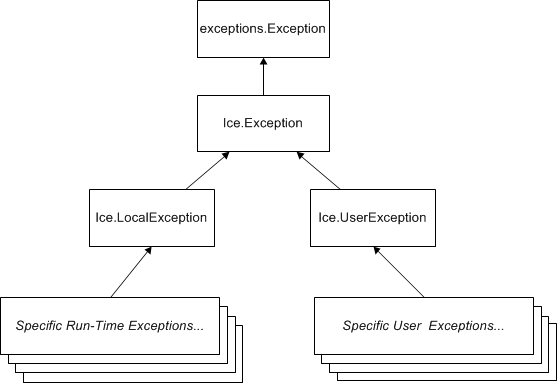Python Mapping for Exceptions
On this page:
Inheritance Hierarchy for Exceptions in Python
The mapping for exceptions is based on the inheritance hierarchy shown below:
Inheritance structure for Ice exceptions.
The ancestor of all exceptions is exceptions.Exception, from which Ice.Exception is derived. Ice.LocalException and Ice.UserException are derived from Ice.Exception and form the base for all run-time and user exceptions.
Python Mapping for User Exceptions
Here is a fragment of the Slice definition for our world time server once more:
exception GenericError
{
string reason;
}
exception BadTimeVal extends GenericError {}
exception BadZoneName extends GenericError {}
These exception definitions map as follows:
class GenericError(Ice.UserException): def __init__(self, reason=''): self.reason = reason def ice_id(self): # ... def __str__(self): # ... class BadTimeVal(GenericError): def __init__(self, reason=''): GenericError.__init__(self, reason) def ice_id(self): # ... def __str__(self): # ... class BadZoneName(GenericError): def __init__(self, reason=''): GenericError.__init__(self, reason) def ice_id(self): # ... def __str__(self): # ...
Each Slice exception is mapped to a Python class with the same name. The inheritance structure of the Slice exceptions is preserved for the generated classes, so BadTimeVal and BadZoneName inherit from GenericError.
Each exception member corresponds to an attribute of the instance, which the constructor initializes to a default value appropriate for its type:
| Data Member Type | Default Value |
|---|---|
string | Empty string |
enum | First enumerator in enumeration |
struct | Default-constructed value |
| Numeric | Zero |
bool | False |
sequence | None |
dictionary | None |
class/interface | None |
You can also declare different default values for members of primitive and enumerated types. For derived exceptions, the constructor has one parameter for each of the base exception's data members, plus one parameter for each of the derived exception's data members, in base-to-derived order. As an example, although BadTimeVal and BadZoneName do not declare data members, their constructors still accept a value for the inherited data member reason in order to pass it to the constructor of the base exception GenericError.
Each exception also defines the ice_id method that returns the Slice type ID of the exception, and the special method __str__ to return a stringified representation of the exception and its members.
All user exceptions are derived from the base class Ice.UserException. This allows you to catch all user exceptions generically by installing a handler for Ice.UserException. Similarly, you can catch all Ice run-time exceptions with a handler for Ice.LocalException, and you can catch all Ice exceptions with a handler for Ice.Exception.
Optional Data Members
Optional data members use the same mapping as required data members, but an optional data member can also be set to the marker value Ice.Unset to indicate that the member is unset. A well-behaved program must test an optional data member before using its value:
try:
...
except ex:
if ex.optionalMember:
print("optionalMember = " + str(ex.optionalMember))
else:
print("optionalMember is unset")
The Ice.Unset marker value has different semantics than None. Since None is a legal value for certain Slice types, the Ice run time requires a separate marker value so that it can determine whether an optional value is set. An optional value set to None is considered to be set. If you need to distinguish between an unset value and a value set to None, you can do so as follows:
try:
...
except ex:
if ex.optionalMember is Ice.Unset:
print("optionalMember is unset")
elif ex.optionalMember is None:
print("optionalMember is None")
else:
print("optionalMember = " + str(ex.optionalMember))
Python Mapping for Run-Time Exceptions
The Ice run time throws run-time exceptions for a number of pre-defined error conditions. All run-time exceptions directly or indirectly derive from Ice.LocalException (which, in turn, derives from Ice.Exception).
By catching exceptions at the appropriate point in the inheritance hierarchy, you can handle exceptions according to the category of error they indicate:
Ice.LocalException
This is the root of the inheritance tree for run-time exceptions.
Ice.UserException
This is the root of the inheritance tree for user exceptions.
Ice.TimeoutException
This is the base exception for both operation-invocation and connection-establishment timeouts.
Ice.ConnectTimeoutException
This exception is raised when the initial attempt to establish a connection to a server times out.
For example, a ConnectTimeoutException can be handled as ConnectTimeoutException, TimeoutException, LocalException, or Exception.
You will probably have little need to catch run-time exceptions as their most-derived type and instead catch them as LocalException; the fine-grained error handling offered by the remainder of the hierarchy is of interest mainly in the implementation of the Ice run time. Exceptions to this rule are the exceptions related to facet and object life cycles, which you may want to catch explicitly. These exceptions are FacetNotExistException and ObjectNotExistException, respectively.
See Also
- User Exceptions
- Run-Time Exceptions
- Python Mapping for Identifiers
- Python Mapping for Modules
- Python Mapping for Built-In Types
- Python Mapping for Enumerations
- Python Mapping for Structures
- Python Mapping for Sequences
- Python Mapping for Dictionaries
- Python Mapping for Constants
- Optional Data Members
- Versioning
- Object Life Cycle
